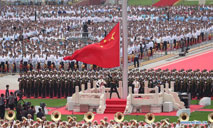Philae temples become landmark of Egypt's Aswan in "greatest archaeological rescue campaign"
Temple caretakers are seen at the Philae temples on Agilkia Island in Aswan, Egypt, on June 26, 2021. On a brief boat voyage in the Nile River in Upper Egypt's tourist city of Aswan, an island called Agilkia appears in the distance, where fortress-like walls surrounding ancient large pylons and columns of a number of temples form the magnificent Philae temple complex. What's more astonishing than the breathtaking view is the fact that the Philae temples did not belong to where they are now. They were submerged by floodwater and later salvaged and relocated from Philae Island to the higher Agilkia Island, 500 meters away, in what the UNESCO describes as "the greatest archaeological rescue campaign of all time." (Xinhua/Ahmed Gomaa)
ASWAN, Egypt, July 8 (Xinhua) -- On a brief boat voyage in the Nile River in Upper Egypt's tourist city of Aswan, an island called Agilkia appears in the distance, where fortress-like walls surrounding ancient large pylons and columns of a number of temples form the magnificent Philae temple complex.
What's more astonishing than the breathtaking view is the fact that the Philae temples did not belong to where they are now. They were submerged by floodwater and later salvaged and relocated from Philae Island to the higher Agilkia Island, 500 meters away, in what the UNESCO describes as "the greatest archaeological rescue campaign of all time."
The UNESCO's international campaign to save the monuments of Nubia ran from 1960 to 1980 and included Egypt's temple complexes of Abu Simbel and Philae, both in Aswan, and others in neighboring Sudan.
The temples were submerged because of the construction of Aswan Low Dam in early 1900s and the later construction of Aswan High Dam in the 1960s.
Abdel-Moneim Saeed, director general of Aswan and Nubia antiquities, said the process of dismantling, relocating and reassembling the Philae temple complex took at least eight years, from 1972 to 1980, before it was reopened to visitors in March 1981.
"It took more than five years to store the dismantled pieces and review the inscriptions and drawings on them at el-Shallal area in Aswan, three km from Philae Island, and then they started to move the pieces to the new site, Agilkia Island," Saeed told Xinhua.
"If building these temples was a miracle in ancient times, I consider as an archeologist that relocating them in that manner and with that technology was also a miracle," he noted.
The Philae temple complex consists of several temples demonstrating historical diversity, for it includes monuments dating back to Pharaonic, Greco-Roman, Coptic and Arabian eras, which is why architecture and art are diversified and mixed inside the temple complex.
It includes the temples of Isis, Horus, Imhotep, Arsenophis, Mandoulis, Nakhtenbo, in addition to the eastern and western columns of the main courtyard, the inner eight-column vestibule, the Birth House (Mammisi), the Nilometer and Hadrian's Gate.
"Relocating the temples of Abu Simbel and Philae via the UNESCO was a very important project for it showed the whole world that the antiquities of Egypt's civilization don't concern Egypt alone but the entire world," said Egypt's top archeologist Zahi Hawass.
"It was one of the most important projects of the UNESCO. Actually, the name of the UNESCO became very renowned for its preservation of the temples of Abu Simbel and Philae," Hawass told Xinhua.
Mostafa Waziri, secretary-general of the Supreme Council of Antiquities (SCA), described the UNESCO international rescue project that involved many donor states as "evidence of the pricelessness of the Egyptian heritage and antiquities."
Being one of the main tourist destinations in Aswan, Philae temple complex is the number one choice for local and foreign tourists visiting the Nubian-oriented city.
"It's the first time in my life to see something so beautiful. It's so huge and magnificent and the details and inscriptions on the walls are indescribable," Lebanese tourist Piotr Nehme said inside the complex, adding he wouldn't have believed those temples were relocated if he hadn't been told.
Alice Kanterian, a woman from Germany, said she thinks Philae temple complex "is probably the most beautiful one in Egypt" after a visit to main temples in Luxor and Aswan.
"I like it (Philae) because it is so well preserved and the ceilings are so high. It gives you a feeling of how the people were living in ancient times," the German tourist told Xinhua at one of Philae temples.
 |
Photos
Related Stories
- Chinese books attract Egyptian readers at Cairo int'l book fair
- Pharaonic wedding ceremony held to revitalize tourism in Giza
- People visit sand sculptures in Hurghada, Egypt
- Egypt's table grape exports grow as global demand increases
- Egyptian expert hails China's speed of COVID-19 vaccine administration
Copyright © 2021 People's Daily Online. All Rights Reserved.











